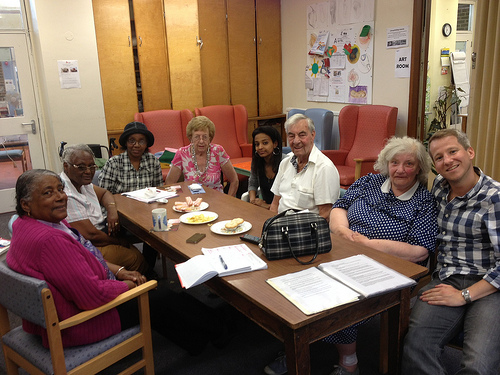Please note: this post is 144 months old and The Cares Family is no longer operational. This post is shared for information only

One of North London Cares’ main aims is to bring older and younger people together to share experiences and learn from one another. Ahead of the launch of our exciting Hidden Heroes project next week, we have spoken to groups of older and younger people to find out how they identify with their local community: what has changed; what has stayed the same; what they love; and what they hate. This is their London.
For people growing up in north London in the 1930s and 40s, there are experiences everyone shared. The Merlin Street baths were built in 1931 and these rows of communal galvanised steel baths are where many of our older neighbours would go to wash and have their clothes laundered. Lil remembers Sundays as bath day, which was a highlight of the week, but if the water went cold, she would have to shout “more hot water in number 4!”
The many markets throughout Islington, Camden and beyond were an important source of produce for the residents of north London. Fred remembers that market traders were not allowed to sell bruised fruit or broken biscuits, but local children would often pick them up at the end of the trading day. Lil remembers this too, and says that she and her friends would bruise the oranges and break biscuits so there would be more for them at the end of the day.
Many older people in north London look back fondly at some of the features of the area that are no longer there: the rag and bone man who gave children a goldfish in return for donating clothes; the milkman who delivered groceries to the door; marching behind the band after Sunday School; evening classes in sewing and pottery before many of the buildings around Angel were bought by Peabody and turned into flats; and the coal men on City Road who delivered to people’s homes.
Transport is a common theme for people reminiscing about growing up in London and many people remember the trams on the City Road that ran throughout the Second World War as well as the trolleybuses which ran until the 1960s; Lillian recalls the poles regularly falling off the overhead lines and drivers having to climb on to the bus to reattach them.
One obvious feature of communities in north London is their cultural diversity and many of the older people we spoke to grew up elsewhere and came to London as young adults. For Joan, who was born in Jamaica but who moved to Archway as a girl, first impressions were key. Joan says: “My mother and pop moved first to London. They sent parcels home – a viewfinder. My sister and I could look through the eyeglass and see London. It seemed like a dream. Look at London! It’s so pretty! Of course, it’s not always that simple then to move here.When I arrived in London I used to say ‘good morning’ to everyone. No one would say hello back to me.”
Cerelia came from Grenada in 1962, and at first found the stark contrast to her home country daunting: “When we arrived here, it wasn’t what we dreamed about. It was boring. I could have taken the next plane back. But I wanted to do something with my life. So I persevered. I looked forward to nurturing a family. I started working. I started meeting other people. And then everything started changing.”
Marina moved to London from the West Indies as a young woman, and remembers on arriving in Plymouth on the boat being surprised to see snow and seagulls, which she had never seen before. She says she was intrigued by her new home: “Back home, I would study by candlelight. Arriving here, there was lots of excitement to outweigh the homesickness: there were the movable stairs!”
Even for people who were born in north London, their early lives represented a time of great upheaval and adjustment. Joan moved around a lot as an evacuee, to Spalding and Cornwall: “Children were taken away from their parents: with a teacher, with a label on you. That was a trauma for us little children.”
Inez, born in Clerkenwell – known as “Little Italy” – in the 1920s, recalls with a chuckle how some of the local children, many of whom are now in their 90s and firm friends of hers, were afraid to play with her because she was part of a large Italian family. But she remembers fondly her mother and aunts sitting on the steps in front of their homes crocheting lace, some of which she still has.

For Lil, born in The Cally, there is only one place she can imagine calling home: “I’ve been abroad – Spain and Germany, France and Belguim – but it’s always nice to come home.” Marina noticed the atmosphere when she arrived from the Caribbean, especially on Sundays when everyone was out in the street: “There was a nice atmosphere on a Sunday. To see people dressed up for church and then Sunday dinner. It all seemed very English.” Fred agrees that he’s lucky to be from here: “I could have been born anywhere – the West Indies, Eritrea, China – but I was lucky: I was born in England. And I was luckier still: I was born in north London.”